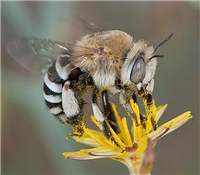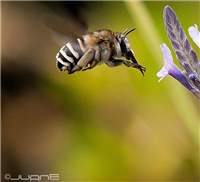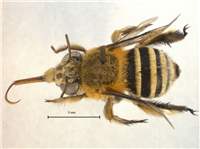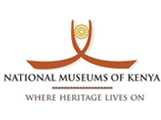Species in the Genus
Species in Kenya, Tanzania & Uganda
Description
Possible Causes of Confusion
Distribution in Kenya, Tanzania & Uganda
Habitats
Nesting
Crops Visited
Other Plants Visited
Economic / Ecological Importance
Threats
Conservation and Management Practices
Legislation (National and International)
References
Editors
Acknowledgements
Contact
Click on images to enlarge

Amegila species. Photo by Louise Docker (CC BY)

Amegila species. Photo by David Marquina Reyes (CC BY-NC-ND)

Amegila species. Photo by Juan Emilio - (CC BY-SA)

Amegilla calens (female) - pinned specimen. Photo: Connal Eardley

Amegilla calens (male) - pinned specimen. Photo: Connal Eardley
Summary
Honey bees are not the only bee species that are significant for human wellbeing. Amegilla bees are a group of native bee species that do not produce honey but are important pollinators of crops and wild plants. Amegilla bees are not aggressive but can sting for defence. They have a mild sting that is much less painful than that of a honey bee. Amegilla bees, often known as banded bees because of their characteristic striped abdomens are medium-sized bees (10-12mm in length) with a golden brown head . Males rest overnight by clinging to plant stems. They live independently of others (i.e. they are solitary) and nest in burrows in the soil, soft sandstone, old mortar or even mud bricks. This fact sheet provides information about these bees to encourage farmers to understand and protect them to help ensure that their crops are effectively pollinated.
From a conservation and agricultural standpoint it is not necessary to recognise all the different bee genera. However, it is important to know that there is a large bee biodiversity. Different bee genera pollinate different plant species, although there is some overlap that acts as a buffer as bee populations wax and wane. For healthy ecosystems, including agro-ecosystems both diversity and abundance in the bee fauna is important.
Scientific Classification
Kingdom: Animalia
Phylum: Arthropoda
Class: Insecta
Order: Hymenoptera
Family: Anthophoridae
Subfamily: Apinae
Tribe: Anthophorini
Genus: Amegilla Friese, 1897
Species in the Genus
About 252 species belonging to the Genus Amegilla have so far been recorded in different parts of the world (ITIS 2010).
Species in Kenya, Tanzania & Uganda
Twenty-seven Amegilla species have been reported in
Description
Amegilla bees are not well known by local people (including farmers) in East Africa as the name bee is generally thought only to apply to honey bees. However, many local people who see them at flowers will possibly know that they are bees but think that they are honeybees. Amegilla bees are about 10-12mm in length with a golden brown head, and the abdomen is striped black and pale blue. Bands may differ with the sex, males having more bands (usually 5) than females (usually 4). Males rest overnight by clinging to plant stems. The female of each species can sting but are not aggressive. Stinging may occur particularly if the bee is trapped inside clothing or caught by hand. However, these bees are not aggressive and will not attack.
Possible Causes of Confusion
To the untrained eye these bees can be confused with honey bees as they are similar in size. All species of Amegilla bee can be easily distinguished from the honey bee by observing their behaviour. Amegilla bees do not make honey that people can harvest and do not live in colonies as honey bees do. Furthermore, Amegilla bees carry their pollen between hairs on the hind legs, whereas in honey bees the hind leg has a smooth spoon-shaped area onto which the pollen is glued. Some species of Amegilla bee resemble some Xylocopa species (carpenter bees) but they differ in size with carpenter bees being larger than Amegilla bees.
Distribution in Kenya, Tanzania & Uganda
Amegilla bees are found in most districts/regions of
Habitats
Amegilla bees can be found in various habitats (land-uses) in
Nesting
Amegilla bees are solitary, nesting in burrows in the soil, soft sandstone, old mortar or even mud bricks. Different species nest in different soil types, which allows them to be present in most ecosystems in
Crops Visited
Amegilla bees often like blue coloured flowers. They are able to perform buzz pollination, which is very important for crops such as tomatoes, eggplants and chillies whose pollen is held firmly by the anthers (Dollin 2001; Bell et al. 2006). This makes them ideal candidates for greenhouse pollination of these crops, which is becoming an important enterprise in
Other Plants Visited
Among the wild plants commonly visited by Amegilla bees are the bottle-brush (family Myrtaceae), grass tree (family Xanthorrhoeaceae) and the saw-edged grass tree (family Xanthorrhoeaceae), all of which are common in East Africa.
Economic / Ecological Importance
Little information exists on the usefulness of these bees to the lives of the people in
Threats
In
Conservation and Management Practices
There are now concerted research efforts in the region to develop best practices for conservation and management of bees that are compatible with other good farm practices, to enhance crop production. Theoretically, bee conservation and management is inexpensive and adopted activities can also improve the aesthetic value of the landscape. Such practices involve setting land aside (e.g. a 1-metre strip) in the farmland to host all year round food resources for the bees, as well as safer sites for nesting, mating, resting and refuge from natural enemies. During flowering, farmers should manage pesticide usage carefully to avoid poisoning flower-visiting bees. Farmers should also minimise pesticide drift from the field to adjacent areas. Laws governing registration and use of plant protection products indirectly play a major role in the protection of pollinators. Trampling by people and livestock and tilling should be managed to conserve the nesting sites of soil-nesting species such as Amegilla bees. KARI (the Kenya Agricultural Research Institute) is developing protocols for mass rearing of different species of solitary bees. Any successful results from this research will be freely communicated to the public. In addition, KARI is collaborating with other stakeholders to ensure in situ conservation and management of bees for pollination purposes. Much of the work of conserving native bees will be underpinned by raising public awareness of the importance of these species.
Legislation (National and International)
There is not yet any legislation in
References
1. Ascher JS (2010) Discover Life bee species guide and world checklist (Hymenoptera: Apoidea: Anthophila). http://www.discoverlife.org/mp/20q?guide=Apoidea_species&flags=HAS: accessed 26 Dec 2010.
2. Bell MC, RN Spooner-Hart and AM Haigh (2006) Pollination of Greenhouse Tomatoes by the Australian Bluebanded Bee Amegilla (Zonamegilla) holmesi (Hymenoptera: Apidae). J Econ Entomol 99(2): 437-442.
3. Dollin A (2001) Blue Banded Bees: Potential Pollinators of Glasshouse Tomatoes. Australian Native Bee Research Centre. http://www.aussiebee.com.au/aussiebeeonline002.pdf, accessed on 31Dec 2010.
4. Eardley, C.D. (1994) The Genus Amegilla Friese in southern Africa (Hymenoptera: Anthophoridae). Entomology Memoir, Department of Agriculture, Republic of South Africa, No. 91, 68 pp.
5. Eardley CD. and Urban R 2010 Catalogue of Afrotropical Bees (Hymenoptera: Apoidea: Apiformes). Zootaxa 2455:1-548.
6. ITIS (2010) Amegilla Friese, 1897: Taxonomic Serial No.: 634005. http://www.itis.gov/servlet/SingleRpt/SingleRpt?search_topic=TSN&search_value=634005. Accessed December 2010.
7. Martins DJ (2004) Foraging patterns of managed honeybees and wild bee species in an arid African environment: ecology, biodiversity and competition. Intern J Trop Insect Sci 24(1): 105–115.
8. Martins DJ (2008) Pollination observations of the African Violet in the Taita Hills,
9. Michener CD (1974) The social behaviour of the bees. Belknap Press,
10. Michener CD (2007) The Bees of the world, the John Hopkins University Press,
Editors
Théodore Munyuli, Busitema University - Uganda; Muo Kasina, Kenya Agricultural Research Institute (KARI) - Kenya; Juma Lossini, Tropical Pesticides Research Institute (TPRI) – Tanzania; John Mauremootoo, BioNET-INTERNATIONAL Secretariat – UK; Connal Eardley, Plant Protection Research Institute (PPRI) – South Africa.
Acknowledgements
We recognise the support from the Kenya Agricultural Research Institute (KARI), Tropical Pesticide Research Institute (TPRI) –
Contact
BioNET-EAFRINET regional coordinator: [email protected]












